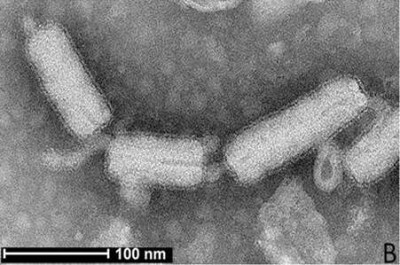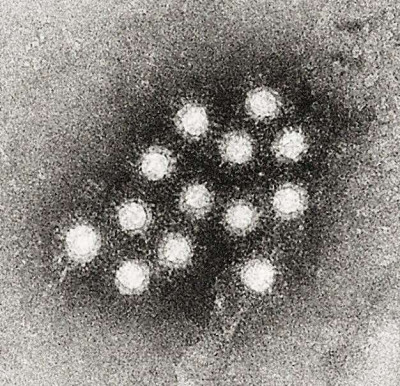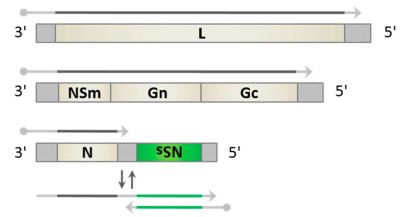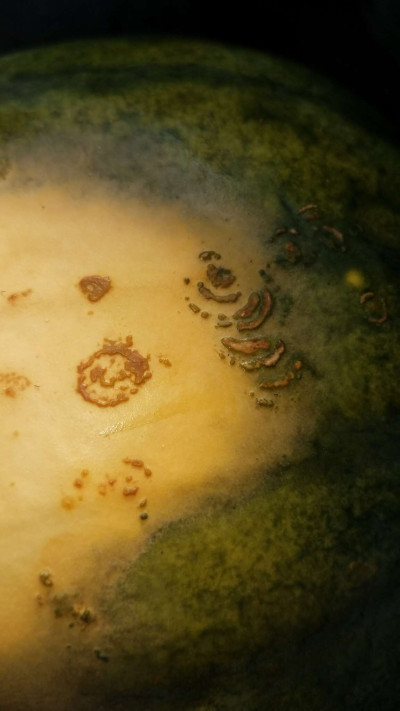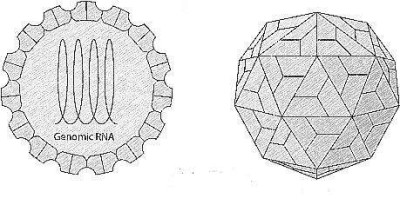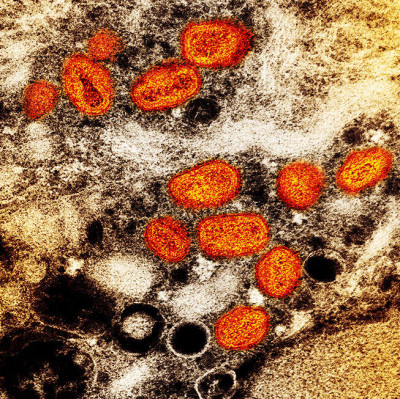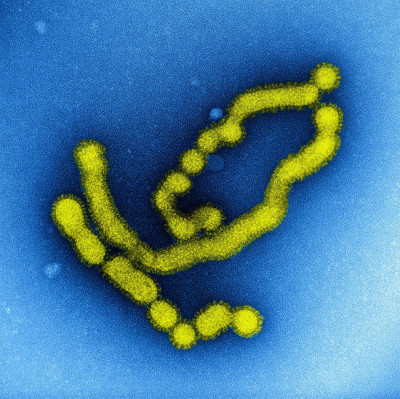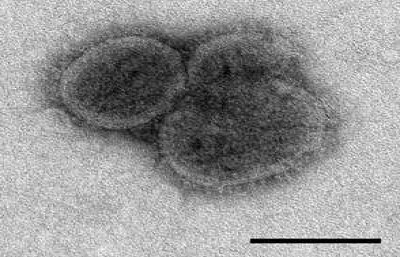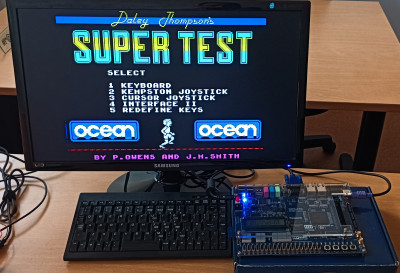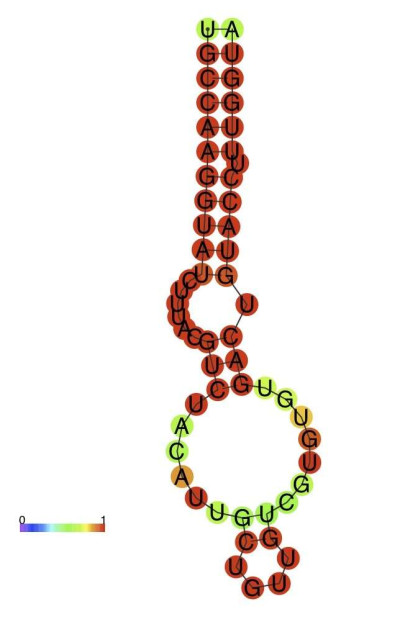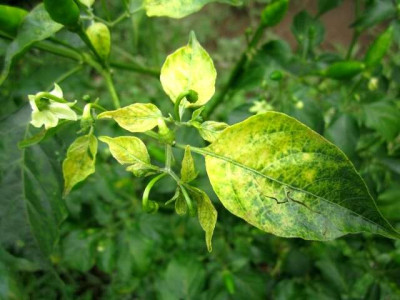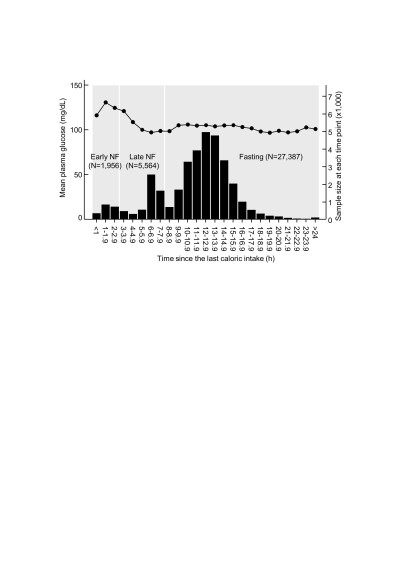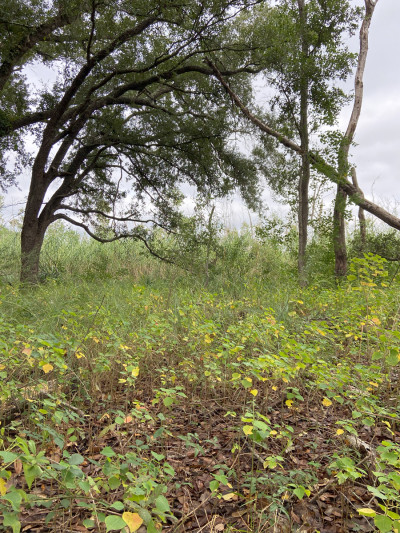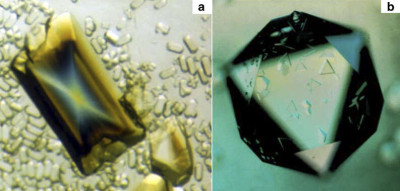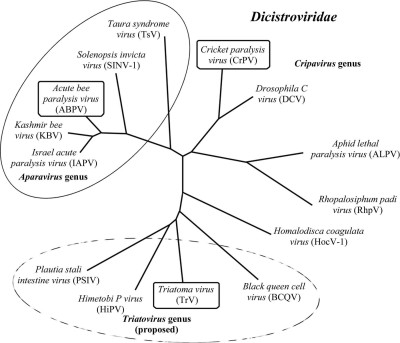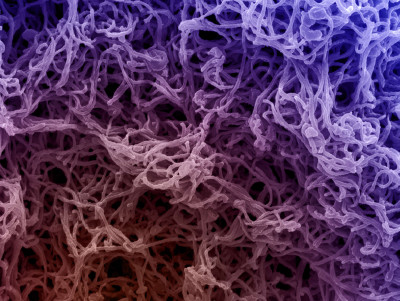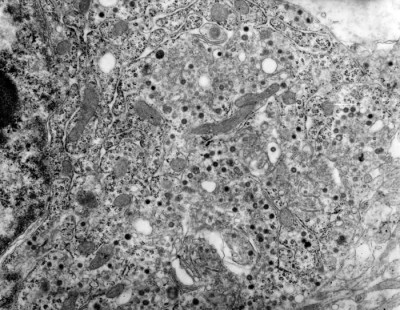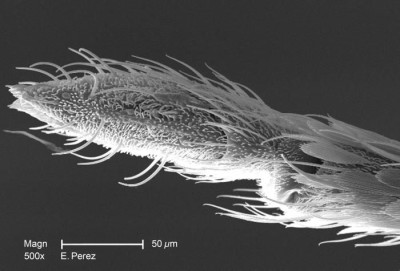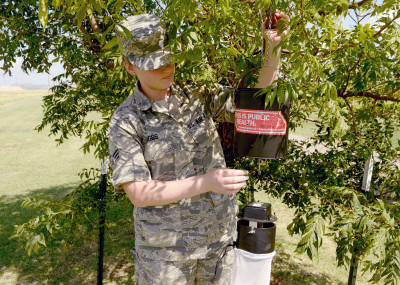Negative-stained sap of infected rice leaves Black arrows indicate the RSMV virions with enveloped. [1]
Wikimedia Commons, Xin Yang, Jilei Huang, Chuanhe Liu, Biao Chen, Tong Zhang, and Guohui Zhou
10 May 2024
Cropped image of an electron micrograph of the Hepatitis A virus (HAV).
Wikimedia Commons, PHIL
08 Apr 2024
Transmission electron microscope (TEM) morphology of phage SH-Ab 15599.
Wikimedia Commons, Yunfen Hua, Tingting Luo, Yiqi Yang, Dong Dong, Rui Wang, Yanjun Wang, Mengsha Xu, Xiaokui Guo, Fupin Hu, Ping He
08 Apr 2024
The three viral genome segments large (L), medium (M) (both being purely negative-sense), and small (S) (ambisense) code for the structural proteins L, the Gn and Gc, and N, respectively. Viral mRNAs contain a 5′-cap (dot) and short heterogenous host-derived sequences. mRNAs transcribed from genomic RNAs are shown as grey arrows. The nonstructural protein NSs mRNA (green arrow) is synthesized from antigenomic RNA (two-colored arrow). Dipteran-borne phleboviruses also encode a nonstructural protein on the M segment (NSm). [1]
Jennifer Deborah Wuerth and Friedemann Weber
18 Apr 2024
Watermelon mosaic virus (WMV) is a plant virus that infects watermelon plants (Citrullus lanatus) and other cucurbit crops, including cucumber, squash, and pumpkin. It belongs to the genus Potyvirus within the family Potyviridae, one of the largest and most economically important virus families affecting plants. Infected plants typically exhibit symptoms such as mosaic patterns on leaves, yellowing or chlorosis, leaf distortion, stunting of growth, and reduced fruit quality and yield. The severity of symptoms can vary depending on factors such as the viral strain, host plant species, and environmental conditions.
iNaturalist
11 May 2024
Sobemovirus is a group of non-enveloped, positive-strand RNA viruses that primarily infect plants, with plants acting as their natural hosts. This genus comprises 21 different species. Diseases linked to Sobemovirus infections include mosaics and mottles.
Wikimedia Commons, Anushashetty
03 Apr 2024
Colorized transmission electron micrograph of monkeypox particles (orange) found within an infected cell (brown), cultured in the laboratory. Image captured at the NIAID Integrated Research Facility (IRF) in Fort Detrick, Maryland.
NIAID
31 Jan 2024
Colorized transmission electron micrograph of negatively stained SW31 (swine strain) influenza virus particles.
Wikimedia Commons, NIAID
01 Feb 2024
Electron microscopic images of novel Thogotovirus isolate, Bourbon virus. Spherical virus particles with distinct surface projection are visible in culture supernatant that was fixed in 2.5% paraformaldehyde. Scale bar indicates 100 nm. [1]
Olga I. Kosoy, Amy J. Lambert, Dana J. Hawkinson, Daniel M. Pastula, Cynthia S. Goldsmith, D. Charles Hunt, and J. Erin Staples, Wikimedia Commons
23 Feb 2024
Demonstration of the game Super Test running on the ZX Fusion.
27 Feb 2024
Secondary structure model of Avian HBV epsilon. Sequence coloured by base paired probabilities using RNAalifold with constraints. This will reflect the updated model for AHBV_epsilon in Rfam 11.
Chris Brown, Wikimedia Commons
29 Feb 2024
Symptom of yellow curl leaf disease in chilli pepper leaves. Klaten, Central Java.
Kembangraps, Wikimedia Commons
01 Mar 2024
Mean plasma glucose concentrations at each hour since the last caloric intake. The line graph represents plasma glucose concentrations, and the histogram represents sample size at each time point. The time since the last caloric intake was divided into three periods: 0-2.9 h (early non-fasting), 3.0-7.9 h (late non-fasting), and ≥ 8.0 h (fasting). NF, non-fasting. [1]
04 Mar 2024
Highlighted in the picture is coastal Louisiana, a region of once sprawling live oaks that are the second layer barriers against hurricanes and tornadoes after barrier islands. The forest regeneration and health is now largely compromised potentially due to increasing salt water intrusion and invasion by Chinese tallow resulting in not only declining forested region but also land loss to sea and mass exodus.
11 Mar 2024
In (a) is an orthorhombic crystal of satellite tobacco mosaic virus (STMV) that is more than 1.5 mm in length and was about 30 times the volume of any STMV crystal ever grown on Earth. It was grown in the Cryostat instrument on IML -1. The small STMV crystals in the background formed after return to Earth when the retrograde solubility of the virus remaining in the mother liquor was induced to crystallize by the heat of the microscope lights used for observation. In (b) is an equivalent sized cubic crystal of the same virus, again, far exceeding in dimensions any grown in an Earth laboratory. [1]
Wikimedia Commons, Alexander McPherson, Lawrence James DeLucas
14 Mar 2024
Phylogenetic classification of the available Dicistroviridae genome sequences constructed using the MEGA5 software. The type species of each genus is boxed. Two genera have been accepted so far: Cripavirus and Aparavirus (continuous ellipse). [1]
Gaëlle Squires, Joan Pous, Jon Agirre, Gabriela S. Rozas-Dennis, Marcelo D. Costabel, Gerardo A. Marti, Jorge Navaza, Stéphane Bressanelli, Diego M. A. Guérinb, and Felix A. Reya
01 Apr 2024
Scanning electron micrograph of filamentous Ebola virus particles budding from a chronically infected VERO E6 cell.
Wikimedia Commons, NIAID
02 Apr 2024
Magnified approximately 34,000x, this transmission electron micrograph (TEM) depicted a tissue section that had been infected with Rift Valley fever (RVF) virus. RVF virus is a member of the genus Phlebovirus in the family Bunyaviridae and was first reported in livestock in Kenya around 1900. It is found to be an acute, fever-causing viral disease that affects domestic animals (such as cattle, buffalo, sheep, goats, and camels) and humans. RVF is most commonly associated with mosquito-borne epidemics during years of unusually heavy rainfall.
Public Health Image Library
11 Apr 2024
Magnified 500X, this scanning electron micrograph (SEM) revealed some of the minute exoskeletal details found at the proboscis tip of an unidentified mosquito found deceased in the suburbs of Decatur, Georgia. The proboscis is the organ used by this, as well as other like insects, to feed upon the blood of a warm-blooded host, including human beings. What is shown here is the sheath that encases a pair of needle-sharp stylets, which together are known as the fascicle. The larger of the two stylets, known as the labrum, when viewed in cross-section, takes on the shape of a V, and acts as a gutter, which directs the ingested host blood towards the insect's mouth. The hair-like structures are known as setae, and are really extensions of the insect's exoskeletal, chitinous covering. These setae act as sensory organs, transmitting impulses indicating changes in the organism's environment.
Public Health Image Library
11 Apr 2024
U.S. Air Force Senior Airman Brandi Spriggs, 97th Medical Operations Squadron health technician, sets up a dry ice trap to catch mosquitoes, Aug. 11, 2016, at Altus Air Force Base, Okla. The Altus AFB Public Health Office is actively testing mosquitoes for viruses and conducting surveillance on mosquito populated areas. (U.S. Air Force photo by Airman 1st Class Cody Dowell/Released)
Wikimedia Commons, Cody Dowell
24 Apr 2024
 Encyclopedia
Encyclopedia
